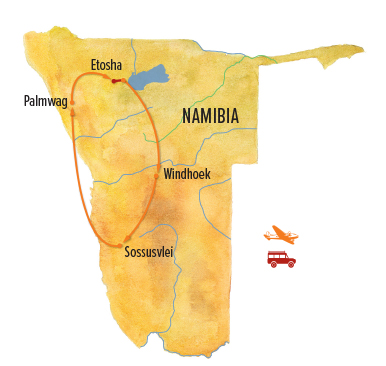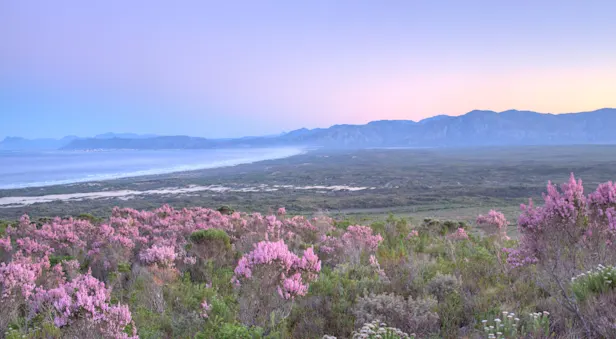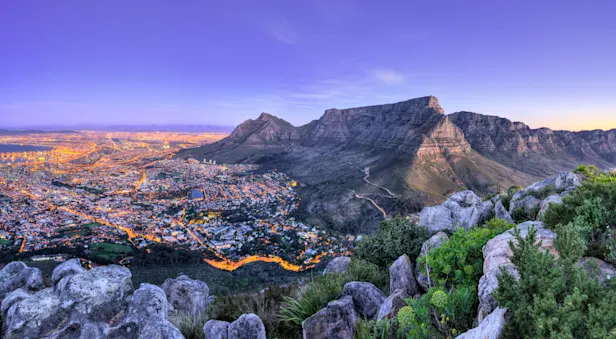Itinerary

Our Namibia photo safari begins in Windhoek, the country's contemporary capital whose eclectic skyline is peppered with German castles, glass skyscrapers and cathedral spires. We meet our Expedition Leader on arrival and settle in to our boutique hotel in one of Windhoek’s leafy and tranquil neighborhoods. Over a leisurely welcome dinner, get acquainted with fellow travelers and learn about the vast landscapes and wildlife we’ll be photographing during an orientation overview.
After breakfast, a mid-morning flight by light aircraft lands us at Little Kulala, a luxury desert retreat within the private 90,000-acre Kulala Wilderness Reserve at the edge of Namibia’s great sand sea. The word namib in the Nama language means “vast,” an apt name for this ancient arid expanse—the world’s oldest desert. From this profoundly secluded vantage point, we’ll have a chance to photograph some of Africa’s most arresting vistas, including vermilion sunsets and black skies glittering with stars. We rise early each morning on dawn excursions to Sossusvlei, Namibia's most legendary landscape. This flat salt and clay pan surrounded by Earth’s tallest sand dunes is a nature photographer's fantasy, as the changing light continually alters the dramatic scene before us. Wildlife drives at sunrise take us into the shape-shifting, ochre-colored dunes at the Namib Desert’s lonely center. Framed by intense blue skies, the dunes glow deep red, transfiguring to burnished orange, then ochre and gold, changing minute by minute as the sun ascends. Inside are diamonds, tucked into the sand mountains by currents, waves and wind.
While wildlife is sparsely distributed in this austere landscape, we have a chance to capture photos of desert species including oryx, ostrich, springbok, spotted and brown hyena, aardwolf and bat-eared fox. The rare dune lark’s entire range is confined to this habitat. Discover the desert’s subtle magic on short walks and safari drives—plus there is an optional opportunity for an early-morning hot air balloon flight over the dunes, a thrilling chance for photographers to capture dramatic aerial views of this wondrous landscape in the rosy glow of sunrise.
Fly north toward Namibia’s Skeleton Coast, whose evocative name references the dried bones of wrecked ships that lay half-buried on beaches battered by fierce Atlantic storms. Our destination, Hoanib Skeleton Coast, is a hospitable outpost amid one of Africa’s last great wildernesses. Set in one of the most fragile ecosystems on Earth, the low-impact camp enjoys a scenic location at the confluence of two tributaries of the dry Hoanib River in the northern part of the private million-acre Palmwag Concession, next to Skeleton Coast National Park. Few safari locales offer the level of isolation found here in one of the most remote regions of the Kaokoveld.
We spend three days immersed in these rugged mountains, vast plains, dune fields and dry riverbeds, with one excursion to the coast itself. A range of activities is designed to maximize photography opportunities, and we explore via 4x4 drives and hides for wildlife viewing. Our bewitching environs are inhabited by a remarkable array of desert-adapted plants and animals, with surprising photo subjects at every turn. Almost miraculously, a multitude of species thrives in the stark inland environment, including Namibia’s largest population of desert elephant. With cameras poised, we hope for sightings of giraffe and lion, oryx, springbok and steenbok. On a guided bush walk (safety permitting), look for scrub hare and inquisitive ground squirrels. During our stay we have one opportunity to visit the Skeleton Coast, driving out and flying back (weather permitting; coastal fog is a regular presence here). A colony of Cape fur seals is often present on shore, and we may spot black-backed jackal and elusive brown hyena near the beach. Birdlife is diverse, with many southern African endemics, and we're likely to spot jaegers and skuas.
Transfer by light aircraft to the Ongava Reserve on the border of Etosha National Park. The Etosha Salt Pan is the remnant of a huge lake that existed here two million years ago. Bare and dry today, the depression offers Namibia’s best wildlife photography opportunities, with elephant, black and white rhino, lion, leopard, cheetah, giraffe, zebra, wildebeest, hartebeest, springbok, oryx, kudu and the diminutive dik-dik drawn to its life-sustaining waterholes. Birdlife is abundant, and we may see ostrich and raptors. We stay on the private reserve adjacent to the park, far from any other accommodations. From camp we take guided walks (safety permitting) and night drives on the reserve, venturing into the park by day to photograph wildlife and scenery.
Our grand Namibia photo safari concludes today as we fly from Ongava back to Windhoek to connect with flights onward.





































